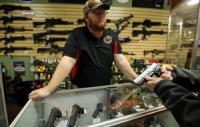-
Israeli police arrest teen over wave of bomb threats against Jewish targets in U.S.
The Israeli police, acting on a request by the FBI, has arrested a 19-year-old Israeli Jewish man on suspicion of making dozens of threats against Jewish organizations in the United States, and against airlines in the United States and other countries. The unnamed teen, who has a dual Israeli and U.S. citizenship, lives in the southern sea-side city of Ashkelon. The arrest was made after several waves of threats in the past two months against Jewish community centers (JCCs) and other Jewish organizations. The teen used advanced technology in an effort to mask the source of his calls and communications to synagogues, community centers, and public venues.
-
-
Most home-grown terrorists in U.K. come from London, Birmingham
A new study takes a detailed, in-depth look at Islamism-inspired terrorism convictions and suicide attacks in the United Kingdom between 1998 and 2015, focusing on the offenders’ backgrounds and their activities as well as offense-specified data. The study finds that the threat to the United Kingdom remains from “home-grown” terrorism, and is heavily youth- and male-oriented, with British nationals prevalent among offenders. Although small, women’s involvement nearly trebled in recent years and is typically supportive of men involved in terrorist activity with whom they have a family or personal relationship. Analysis of offenders’ residence shows the primacy of London- and Birmingham-based individuals as well as higher than average relative deprivation and Muslim population at neighborhood level.
-
-
Problems associated with enlisting local police for immigration enforcement
As a candidate and now as president, Donald Trump has described undocumented immigrants as a threat to public safety and has promised to create a “deportation force” to remove millions of immigrants from the country. Through his words and actions, President Trump has indicated that he aims to enlist state and local law enforcement in this deportation force through both inducement and coercion, by aggressively promoting the 287(g) program and threatening to cut federal funding of so-called sanctuary jurisdictions. Law enforcement personnel already face enormous challenges with limited resources. In the coming months, many state and local officials and local law enforcement agencies will face a choice: whether and how to assume a greater role in enforcing federal immigration laws.
-
-
U.S. crime rates declined in period of high immigration: Reports
The number of immigrants in the United States has risen from 3.5 million in 1990 to 11.1 million in 2014, but two new studies show that an increased number of immigrants in the country might have been associated with a historic decline in crime rates. The studies – Immigration and Public Safety from the Sentencing Project and Criminal Immigrants Their Numbers, Demographics, and Countries of Origin from the CATO Institute — also shows that immigrants are less likely than U.S.-born citizens to commit crimes and be imprisoned.
-
-
How online hate infiltrates social media and politics
In late February, the headline of a news commentary website that receives more than 2.8 million monthly visitors announced, “Jews Destroy Another One of Their Own Graveyards to Blame Trump.” With only a headline, this site can achieve something no hate group could have accomplished twenty years ago: It can connect with a massive audience. Looking at the most-visited websites of what were once diminished movements – white supremacists, xenophobic militants, and Holocaust deniers, to name a few – reveals a much-revitalized online culture. To whom, and how many, this latest conspiracy may travel is, in part, the story of “fake news,” the phenomenon in which biased propaganda is disseminated as if it were objective journalism in an attempt to corrupt public opinion. Today’s radical right is also remaking its profile, swapping swastikas and white-power rock for political blogs and news forums. The trappings may have changed, but the bigotry remains. Hate rhetoric repackaged as politics and housed in websites that look just like any other online blog can attract, or even persuade, more moderate ideologues to wade into extremist waters. This “user-friendly” hate community is joining forces in a way that could never happen in the offline world. Thanks in part to this connectedness, these poisoned narratives are now spreading well beyond racist websites.
-
-
Predicting crime knowledge states in the human brain
Judges and juries always ponder whether people act “knowingly” or “recklessly” during criminal activity — and neuroscience has had little to add to the conversation. But now, researchers have discovered that brain imaging can determine whether someone is acting in a state of knowledge about a crime — which brings about stiffer penalties — or a state of recklessness, which even in capital crimes such as homicide, calls for less severe sentences.
-
-
The loaded history of self-defense

After the killing of 17-year-old Trayvon Martin in 2012, Harvard historian Caroline Light felt compelled to explore the roots of the American right to self-defense, which has helped turned the United States into a country with more guns than people. In her new book, Stand Your Ground: A History of America’s Love Affair with Lethal Self-Defense, Light traces the development of the notion of self-defense from English common law to contemporary stand-your-ground gun laws.
-
-
White supremacists dramatically increase recruitment efforts on U.S. college campuses

White supremacists, emboldened by the 2016 elections and the current political climate, are currently engaged in an unprecedented outreach effort to attract and recruit students on American college campuses. The Anti-Defamation League (ADL) has cataloged 107 incidents of white supremacist fliering on college campuses since the school year began in September 2016, with surge of activity since January 2017, when 63 of the total incidents (61 percent) occurred.
-
-
More black police will not result in fewer police-involved homicides of black citizens
Hiring more black police officers is not a viable strategy for reducing police-involved homicides of black citizens in most cities, according to new research. The study finds that, for many cities, it would take a massive increase in the percentage of black police officers to reduce the number of police-involved shootings of black citizens. Adding just a few black officers, the researchers say, won’t help and might make matters worse.
-
-
Threats of violent Islamist and far-right extremism: What does the research say?
The 9/11 attacks were perpetrated by Islamist extremists, resulting in nearly 18 times more deaths than America’s second most devastating terrorist attack – the Oklahoma City bombing. More than any other terrorist event in U.S. history, 9/11 drives Americans’ perspectives on who and what ideologies are associated with violent extremism. But focusing solely on Islamist extremism when investigating, researching and developing counterterrorism policies goes against what the numbers tell us. Far-right extremism also poses a significant threat to the lives and well-being of Americans. This risk is often ignored or underestimated because of the devastating impact of the 9/11 terrorist attacks.It remains imperative to support policies, programs, and research aimed at countering all forms of violent extremism.
-
-
Assault weapons not protected by Second Amendment: U.S. appeals court

The U.S. Court of Appeals for the Fourth circuit ruled 10-4 to uphold Maryland’s ban on assault weapons, ruling that assault weapons are not protected under the Second Amendment of the U.S. Constitution. “Put simply, we have no power to extend Second Amendment protection to the weapons of war,” Judge Robert King wrote. “Both before and after Newtown, similar military-style rifles and detachable magazines have been used to perpetrate mass shootings in places whose names have become synonymous with the slaughters that occurred there,” he wrote.
-
-
Hate groups increase for second consecutive year, while Patriot groups decline
The number of hate groups in the United States rose for a second year in a row in 2016, according to the SPLC annual census of hate groups and other extremist organizations, released yesterday. The most dramatic growth was the near-tripling of anti-Muslim hate groups — from 34 in 2015 to 101 last year. Figures compiled by the FBI dovetail with those of the SPLC – and the latest FBI statistics show that hate crimes against Muslims grew by 67 percent in 2015, the year in which Trump launched his campaign. In contrast to the growth of hate groups, antigovernment “Patriot” groups saw a 38 percent decline — plummeting from 998 groups in 2015 to 623 last year.
-
-
No link between immigration and increased crime: Research
Political discussions about immigrants often include the claim that there is a relationship between immigration patterns and increased crime. However, results of a new study find no links between the two. In fact, immigration actually appears to be linked to reductions in some types of crimes, according to the findings. “It’s important to base our public policies on facts and evidence rather than ideologies and baseless claims that demonize particular segments of the U.S. population without any facts to back them up,” says one of the researchers.
-
-
Temporary gun removal law shows promise in preventing suicides
A Connecticut law enacted in 1999 to allow police to temporarily remove guns from potentially violent or suicidal people likely prevented dozens of suicides, according to a new study. In their review of 762 gun-removal cases, the authors calculate that for every 10 to 20 instances of temporary gun seizures, one suicide was prevented.
-
-
House ends rule preventing mentally ill people from buying guns
The House voted 235-180 to allow mentally ill people to buy and own guns. Lawmakers overturned a regulation which went into effect last year – and which affected about 75,000 people – which required the Social Security Administration to relay names of Social Security recipients diagnosed with mental health conditions, such as extreme anxiety and schizophrenia, and who are considered incapable of managing their own affairs. The names of these individuals were added to a database of citizens who are ineligible to purchase a firearm.
-
More headlines
The long view
How Male Grievance Fuels Radicalization and Extremist Violence
Social extremism is evolving in reach and form. While traditional racial supremacy ideologies remain, contemporary movements are now often fueled by something more personal and emotionally resonant: male grievance.
